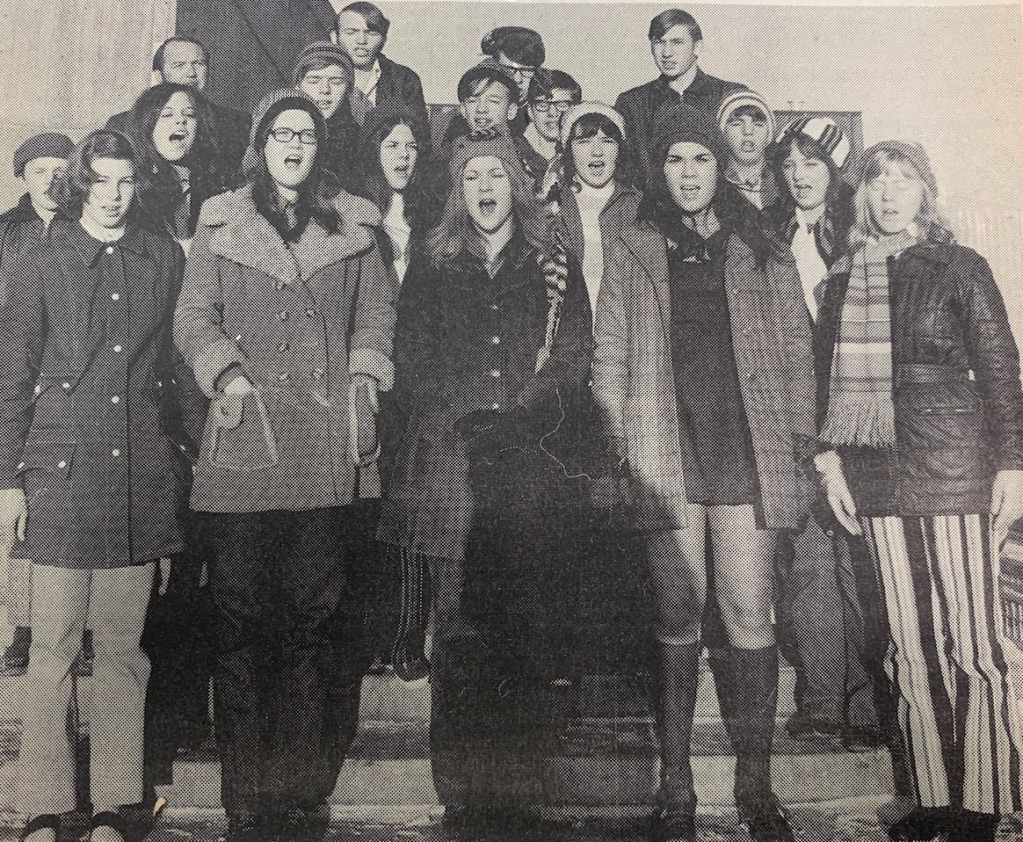Flashback: Christmas caroling, holiday mail and water shortages
Published 12:00 am Wednesday, December 15, 2021

- The Redmond High School Minstrels in 1971.
100 years ago
Dec. 22, 1921 — Shortage of water due to slush ice in the river
The present cold spell and heavy snow storm has caused a shortage in Redmond’s water supply. The city pumping plant located at Cline Falls and installed several years ago is run by the turbine, fed by a half-mile of flume. During such weather as now prevails the river is full of slush ice which floats below the surface and freezes the bottom and this slush ice clogs the flume and the small gates admitting water to the turbine and then freezes.
Every effort has been made to keep the pump running, Marshal Julian and a crew of men having endeavored to keep a double shift kept the pump running day and night as long as the power was available. This trouble, which has occurred every cold winter, will be obviated as soon as the new electrical driven pump with a capacity of nearly half a million gallons every 24 hours, is installed. As these pumps have to be built to fit the job, it will be two month before it is delivered and installed. The new pump will be connected with both the Cline Falls and Cove power plants, so if one is out of commission, the other can be drawn on. The intake will be in a deep hole in the river bed below the slush ice level.
At present, Redmond is getting light and power from the Cove plant, which is now affected by cold weather. No relief from the water shortage can be expected until chinook or thaw takes the ice out of the Deschutes.
75 years ago
Dec. 19, 1946 — Record fall at post office
Previous mailing records were shattered at Redmond post office this week with incoming and outgoing mail running 40 per cent higher than during the Christmas rush last year, Postmaster Arthur Tifft reported today.
As a service to patrons, the post office will remain open from 8 a.m. to 6 p.m. Saturday, and for a short time after 8 o’clock Christmas morning to enable addressees to call for parcels.
About 8,000 letters per day are now going through the offices canceling machine, Tifft said, and over 70 sacks of mail were dispatched Tuesday. Incoming mail is just beginning to reach peak volume, with Monday being the heaviest day for incoming mail to date.
The Christmas rush started the latter part of last week, and is expected to continue throughout this week. Although the post office is crowded with all classes of mail, Tifft expects to get by with space now available. To speed the turnover, clerks are working overtime.
Greeting cards are mailed at the one and a half cent rate continue to lead other classes in mailing, but the postal department advises patrons to use first class for this purpose because it has a priority in handling and may be forwarded. Tifft pointed out that patrons should use care in wrapping parcels because many packages are becoming unwrapped during transit.
50 years ago
Dec. 15, 1971 — Christmas music to fill the air in greater Redmond
Christmas music will fill the air in the greater Redmond area over the next week, as school choral and band groups present a variety of concerts and old-time caroling favorites without charge throughout the community.
Leading off tonight at 7:30 o’clock will be Lone Pine School program, featuring the tiny school’s band, a lower grade skit, upper grade play, piano solos and choral groups.
Tomorrow, Dec. 16, the Redmond Junior High School concert will be presented in the new high school auditorium at 7:30 p.m. Choral director Robert Thornton will lead the choir in “Angels We Have Heard on High,” “Ding Dong Merrily on High,” Deck the Halls with Holly,” “Silent Night,” and “What Child Is This?”
The junior high band, under Tom Kranovich, will play “Christmas in England,” “Continental Christmas,” “Carillons at Christmas,” “Christmas for Winds,” “Christmas Party,” and “Carol of the Drum.”
Highlights at both the junior and senior high concerts will be a backdrop of holiday decor in the new RHS auditorium and an appearance by the jolly old elf himself. At the Redmond High program, to be held at 8 p.m. Tuesday, Dec. 21, he will come loaded with goodies for tiny tots in the assemblage. RHS choral selections will include “Do You Hear What I Hear?” and sing-alongs of popular carols with audience participation, under Thornton’s directions.
Clyde Moore will lead the band in “Carols for Christmas,” by John Cacavas, “Home for Christmas,” arranged by Seth Markham, “prelude and Fugue in E Minor,” transcribed by Carroll de Camp from J. S. Bach’s “Little Prelude and Fugues,” “Brazilian Sleigh Bells,” by Percy Faith and arranged by John Warrington, and “Christmas Song,” of Mel Torme fame. The concert choir and band will join in the “Hallelujah Chorus.”
Terrebonne on Monday, Dec. 20, and Tumalo on Wednesday, Dec. 22, will be the scene of Christmas programs, directed by Ron McNutt and including every student in the two schools. The 8 o’clock presentations in the respective school gyms will feature skits, singing, bands, appearances by Santa and grand finales of audience sing-alongs.
At Terrebonne, a highlight will be a 30-minute rendition of Dickens’ “Christmas Carol” by Bill Graham’s sixth graders. The exercise in language arts has found students challenging for leading parts over the last couple weeks. In Tumalo, Dennis Heap’s fourth graders will enact a Christmas tableau.
The final musical gift to the community will be an all-day caroling program on Thursday, Dec. 23, by the RHS Minstrels, led by Thornton. The morning will be spent entertaining youngsters in the Redmond grade schools; the afternoon, touring all area nursing homes, Central Oregon District Hospitals and the Opportunity Center of Central Oregon.
The Minstrels are sopranos — Molly Warden, Cindy Wilde, Debbie Wise, Dee York, Cyndy Green and Gwen Wheeler; altos — Dawn Fischer, Sue Green, Marilee Shannon, Vicki Tischmak abd Debbie Carpenter; tenors — Eldon Simpson, Harold Childres, Lyle Darrow and Tom Easlon; base — Rob Erbes, Steve Clary, Jan Cooke, Ken Shaw and Kenneth Kuper.
After six hours of caroling, Thornton said the Minstrels would gather for their own get-together, even if loss of voices reduced the conversation to sign language.
25 years ago
Dec. 18, 1996 — Students go to bat for nocturnal friends
Bats in the belfry, bats on walls, but don’t try telling Mary Kimmel’s second and third graders at Evergreen School that bats are bad or evil.
They know better after studying bats this fall. And a small bat stopping briefly at the school benefited from that knowledge.
The bat was discovered clinging to the wall near the school’s cafeteria, and it immediately became a target for rocks and playground balls.
That is, until students from Mrs. Kimmel‘s class got wind of the visitor.
“A number of them became quite motherly,” Kendall said.
The children organized a rotating protection team to keep their schoolmates from harassing or injuring the bat.
“They were trying to get him down to look at him and be mean,” pupil Stacy Sergeant said.
Bats are nothing to be frightened of, added Jared Dubisar. “They’re really scared of things. They’re 10 times more scared of you than you are of them.”
Besides, the bat was unlikely to hang around long.
“When they are traveling, they only stay in one place 24 hours,” Sage Imel said.
Vampire bats don’t live in this area, Imel assured his friends after studying the species.
While standing guard, the students became teachers, letting other children know bats are beneficial animals.
“I think they are good to humans, and they eat insects,” Michelle Sorum said. “One town killed all their bats, and some people died because there were so many mosquitoes with diseases.”
If humans do get sick, bat saliva might even be used to help cure them, the students alleged.
“Bat saliva is used in hospitals to keep blood flowing so the veins don’t get clogged up,” Dubisar said.
(It seems bats have an anticoagulant in their saliva.)
“Every bat has a purpose,” Dubisar said. “Fruit bats pollinate fruit.”
The Evergreen bat encounter helped drive home the lessons Kimmel was teaching in her class.
“I realized bats are pretty interesting,” Imel said.
The incident may even have dispelled some of the bad press bats have been saddled with for generations. Most of the students said they found bats less mysterious and threatening then before the bat study.
Bailey Smith admitted that, while she still doesn’t like bats, “I’m not as scared of them as I was.”





